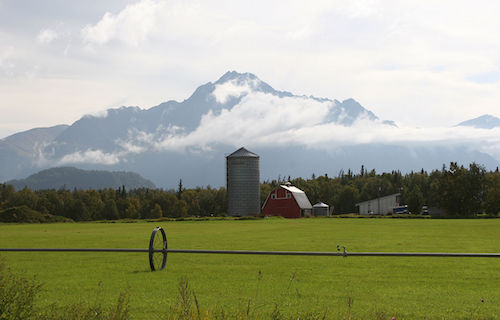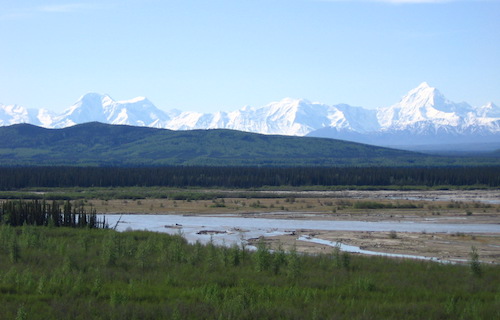Murkowski Helps Advance First Four Spending Bills with Alaska Wins
Washington, DC – Yesterday, U.S. Senator Lisa Murkowski (R-AK), a senior member of the Appropriations Committee, voted to advance four bills for Fiscal Year 2026 (FY26) that contain significant investments for Alaska. The four appropriations bills that passed committee are for Agriculture, Rural Development, Food and Drug Administration, and Related Agencies (AG); Military Construction, Veterans Affairs, and Related Agencies (MilCon); Commerce, Justice, and Science and Related Agencies (CJS); and Legislative Branch (LEG). All were approved in committee, and will now advance to the Senate floor for consideration.
“With crucial investments in affordable housing, infrastructure, public safety, and fisheries, we are addressing some of the most pressing challenges faced by Alaskans, and helping the sustainability and future of not only our communities, but our way of life. I am proud to fight for Alaskan priorities and ensure that our state’s needs are met,” said Senator Murkowski.
HIGHLIGHTS FROM THE COMMERCE, JUSTICE, AND SCIENCE (CJS) APPROPRIATIONS BILL
Supporting NOAA’s Mission in Alaska
The National Oceanic and Atmospheric Administration (NOAA) is a vital partner for the state of Alaska, leveraging partnerships at federal, state, local, and Tribal levels. NOAA provides everything from real time weather forecasts to fisheries monitoring, so that our communities are safe and our way of life is sustainable. To that end, Senator Murkowski prioritized ensuring the agency had programmatic support from the CJS Appropriations Bill to further advance their core missions in Alaska.
One of the largest wins included $75 million for NOAA to recapitalize vessels, so that the fleet can continue to provide state-of-the-art weather forecasts and fisheries monitoring. The budget also included a $1 million increase for the Integrated Ocean Observing System (IOOS) Regional Observations, which directly supports Alaska’s Ocean Observing System.
Wins for NOAA Fisheries that will support sustainable seafood harvesting and conserving habitat:
- $10 million increase for Fisheries Surveys to support the historical levels of Alaska trawl surveys and exploring shifting fish stocks
- $3.125 million for the Bycatch Reduction Engineering Program (BREP), an increase of $250,000. This program was established to develop improved fishing practices and gear technologies in the effort of reducing bycatch.
- $4 million for the Fishery Survey Contingency Fund, which was established through the U.S. Treasury to compensate Alaska fishermen for economic losses.
- $5.5 million increase for Salmon Management Activities, which will be used to support the production of 42 million hatchery fish, to help increase the harvest for Tribal, commercial, and recreational fisheries.
- $41.5 million for the Pacific Salmon Treaty, a $500K increase from last fiscal year. This funding will go towards joint United States/Canada management of salmon fishing to prevent over-fishing and provide for optimum harvest
- $58.4 million for Observers and Training, including $2 million for the North Pacific Observer Program. These programs are essential for the conservation and management of fisheries in the Bering Sea, Aleutian Island, and Gulf of Alaska
Wins for NOAA Weather & Climate Monitoring Systems
- $5 million increase for the National Data Buoy Center (NDBC). The NDBC is a network of monitoring infrastructure that collects and analyzes real-time data to ensure maritime safety.
- $10 million increase for Analyze, Forecast, and Support – includes language supporting tsunami detection and response systems relevant to Alaska.
Advancing Connectivity in Alaska
Senator Murkowski has set herself apart with her focus on broadband infrastructure in Alaska, shepherding record investment to the state through the Infrastructure Investment and Jobs Act (IIJA) of 2021. She continues to be a leader in the space, inserting report language in the Tribal Broadband Connectivity Program that acknowledges Alaska’s challenges with short construction seasons and logistics, laying the groundwork for future flexibility and support if needed. She also directed the National Telecommunications and Information Administration (NTIA) to consider supplemental funding that would ensure rural and remote Tribal projects are completed.
Promoting Public Safety in Alaska
Public safety in Alaska is always foremost on Senator Murkowski’s mind—particularly in our rural communities. She used the CJS bill as a vehicle for direct investment towards advancing that goal. The bill includes an increase in funding for the Tribal Youth Program, which does everything from improvements to the juvenile justice system, invest in alcohol and substance abuse prevention programs, and offer mental health services for Tribal youth. She was able to secure a 5% Tribal Set-Aside in the Crime Victims Fund along with strong report language that supports Tribal flexibility and streamlined access. The Senator also included increased funding for Special Tribal Criminal Jurisdiction, with language supporting Missing and Murdered Indigenous Women (MMIW) efforts and improved Department of Justice (DOJ) grant coordination for Native communities. Additionally, the bill follows up on the Government Accountability Office (GAO) report on MMIW with a directive for immediate reporting.
Alaska faces some of the highest rates of sexual assault per capita of any state, and Senator Murkowski was intent on using the CJS bill to address this crisis. She approved an almost tripling of the Sexual Assault Forensic Exam Grants funding, which will support training and resources for forensic examination of sexual assault survivors. The Senator also included report language directing the Office for Victims of Crime/Office of Juvenile Justice and Delinquency Prevention to support Alaska-specific Child Advocacy Centers.
The bill also includes funding increases for Transitional Housing Assistance, Underserved Populations Program, Regional Information Sharing Systems, and Veterans Treatment Courts.
Investing in Arctic Research
As the leading expert in Congress on Arctic policy and polar affairs, Senator Murkowski uses her position to advance American priorities in the North. The bill provides $9.1 billion, just $60 million below the last enacted level – preserving support for critical Arctic scientific research despite tight fiscal constraints. Arctic research remains a priority, with the National Science Foundation (NSF) playing a key role in supporting long-term monitoring, infrastructure development, and partnerships with Alaska-based institutions and Indigenous communities.
In addition to broader programmatic funding to help Alaskans, Murkowski was able to secure investments in this bill that are specific to local 17 Alaska communities or entities, projects that have been requested and prioritized by local governments and organizations:
- Anchorage: $305,000 to support the Internet Crimes Against Children Task Force in Alaska so they can further advance their mission of catching child sexual predators
- Anchorage: $1.5 million for the University of Alaska Anchorage to acquire specialty equipment that will help propel the institution to be a leader in biotechnological innovation, leveraging Alaska’s Arctic environment
- Bethel: $70,000 for the purchase and installation of a new security system at the Bethel Police Department’s headquarters
- Cordova: $355,000 to update equipment for climate and ecosystem monitoring as part of a ten-year long study of the region
- Fairbanks: $1.5 million to develop drone-borne maritime lidar to count salmon.
- Statewide: $498,000 for the creation and deployment of a Mobile Sexual Assault Response Team (SART) that will provide coordinated care to survivors of sexual assault in rural communities where traditional, stationary services may not be readily available
- Southeast: $500,000 for Sealaska Heritage Institute to develop and implement a sustainable workforce development program to address growth in fisheries and ocean sciences in Southeast Alaska over the next ten years
- Ketchikan: $3 million to upgrade its radio communication system, which has been identified as an essential public safety need in the after-action plan following recent landslides to improve disaster response and community resilience
- Statewide: $2 million for the Alaska Fisheries Development Foundation to modernize and revitalize Alaska's seafood industry by investing in processing innovation, workforce development, and infrastructure improvements.
- Statewide: $2.5 million for the North Pacific Research Board to investigate how ecosystem changes in the Northern Bering Sea influence species of commercial, ecological, and subsistence importance to inform local, state, and federal fisheries management
- Statewide: $1 million to help implement Next Generation 911, which will improve location accuracy and system resiliency for emergency call centers
- Statewide: $500,000 for the Bering Sea Fisherman’s Association to enable Tribes and Tribal organizations to participate as Cooperating Agencies in environmental analysis and management decisions made by federal agencies that affect subsistence resources.
- Statewide: $165,000 for the Alaska Ocean Observing System to purchase an Imaging Flow CytoBots (IFCBs) to continue monitoring for harmful algal blooms.
- Statewide: $1 million for Alaska Native Women’s Resource Center to support Tribes in implementing survivor-centered and trauma-informed programs in Tribal justice systems
- Statewide: $3.5 million for the Alaska Network on Domestic Violence and Sexual Assault (ANDVSA) to support their mission of serving survivors of gender-based violence
- Unalaska: $3.5 million for the Bristol Bay Science and Research Institute to genetically analyze chum salmon from the pollock fishery bycatch in the Bering Sea to determine when and where Western Alaska chum salmon are being caught
- Valdez: $5.5 million to replace obsolete and failed emergency services communication towers and equipment
HIGHLIGHTS FROM THE AGRICULTURE, RURAL DEVELOPMENT, FOOD AND DRUG ADMINISTRATION, AND RELATED AGENCIES (AG) APPROPRIATIONS BILL
Investments in housing and community development
Affordable housing remains one of the most pressing challenges facing Alaska and our country. Senator Murkowski was intent on using the AG spending bill to address this challenge, particularly in rural communities where the cost of development remains prohibitively high. She supported $1.715 billion for the Rental Assistance Program, which will help low-income families around the country with for affordable rental housing in rural areas. She was able to secure $25 million for very low-income housing repair grants so that Alaskans can stay in their homes safely.
Also included in the legislation was $1.25 billion for direct loans to improve critical infrastructure such as public safety buildings and community centers in rural communities.
Updating Alaska’s clean water and utility infrastructure
Senator Murkowski has made it her mission to ensure Alaska has the infrastructure to support daily life – no matter what community Alaskans’ call home. She was able to include $65 million for Rural Water and Waste Disposal Grants, and inserted report language that would prioritize Alaska Native communities. She also was able to secure $8 million for the High Energy Cost Grant Program, which assists energy providers in lowering energy costs for families with extremely high per-household energy costs.
Bolstering food security and agriculture
Senator Murkowski has been focused on bolstering Alaska’s food security for many years. She was able to secure a number of Alaska-specific wins, including:
- $5 million for Micro-Grants for Food Security, with report language prioritizing eligibility for reindeer herders, greenhouse growers, and hydroponic farmers
- $5 million for Alaska Native-Serving Institutions to promote equal access to education in rural Alaska and provide sustainable food and energy solutions for Alaska Native communities
- $3.5 million for the Geographically Disadvantaged Farmers and Ranchers Transportation Program, helping offset high freight costs for Alaskan producers
- $3 million for the FDPIR 638 Contracting Authority Pilot, with direction for the USDA to allow direct purchases of traditional foods directly from small indigenous producers
- $888.9 million for the Summer Food Service Program, with report language supporting the continued implementation of non-congregate meal service to ensure low-income students can eat while school is out
- $1.826 billion for Agricultural Research Service, with continued funding for research on cover crops and cereal grains for northern climates and permafrost regions
In addition, the bill includes $80 million for The Emergency Food Assistance Program’s storage and distribution funding to ensure rural food banks can receive supplies; a $3 billion increase for Child Nutrition programs, including School Breakfast and School Lunch programs, and the Child and Adult Care Food Program, as well as a $603 million increase to fully fund Special Supplemental Nutrition Program for Women, Infants, and Children (WIC). The bill also directs USDA to work with states, tribes, and local stakeholders to use federal nutrition dollars for the direct purchase of foods from local and regional producers for the various food assistance programs.
In addition to programmatic funding to help Alaskans, Murkowski was able to secure investments in this bill that are specific for 10 Alaska communities, projects that have been requested and prioritized by local governments and organizations:
- Bethel: $605,000 to establish a permanent Food Bank and Pantry in Bethel
- Eagle: $750,000 for the construction of a fire hall/public safety building for the local fire department and Emergency Medical Services team
- Houston: $1.95 million for the construction of Public Works Facility so preventive maintenance can be performed on equipment
- Kenai: $2.045 million for the installation of telecommunications infrastructure to improve emergency response times and enhance public communications
- Nunapitchuk: $55,000 to develop a Preliminary Investigation Feasibility Report whether the Native Village of Nunapitchuk can pursue a community-wide relocation project in the Nunavakanukakslak Lake-Johnson River Watershed
- Petersburg: $225,000 to purchase emergency response equipment for the local fire department
- Statewide: $4.2 million for Alaska Municipal League to purchase heavy equipment for several communities designed to conduct road improvements and maintain infrastructure in rural Alaska
- Statewide: $750,000 to expand veterinary care in rural Alaska to prevent zoonotic disease outbreaks in communities off the road system
- Whittier: $310,000 for the removal and abatement of asbestos hazards in community housing where 85% of the city’s residents live
- Wrangell: $2.438 million to rehabilitate Wrangell’s Public Safety Building and Emergency Operations Center
HIGHLIGHTS FROM THE MILITARY CONSTRUCTION, VETERANS AFFAIRS, AND RELATED AGENCIES (MILCON) APPROPRIATIONS BILL
Ensuring Alaska’s military bases are state-of-the-art facilities
Senator Murkowski is committed to supporting servicemembers in Alaska to ensure they have access to up-to-date resources as they protect and defend our nation, but also bolster their personal well-being as they adapt to life in Alaska. She secured over $400 million in programmatic funding for a Joint Integrated Testing and Training Center (JITTC) at JBER for the Air Force, a base supply complex at JBER for the Air National Guard, and a barracks at Fort Wainwright for the Army.
Supporting Alaska’s veterans
Senator Murkowski was able to secure funding for the construction of State Extended Care Facilities and Veterans Cemeteries. She also secured report language directing the VA to focus on benefits eligibility education for veterans who lack a direct road connection to a VA facility. She also secured her annual bill language to allow for care-sharing agreements between Federally Qualified Health Centers in the State of Alaska and Indian Tribes and Tribal organizations which are party to the Alaska Native Health Compact with the Indian Health Service. She made certain that the VA received full funding for mental health programs, telehealth programs, women veteran gender-specific care programs, homelessness programs, and for the Office of Rural Health.
In addition to programmatic funding, Murkowski was able to secure investments in this bill that are specific for 3 of Alaska military installations, projects that have been requested and prioritized by the Department of Defense:
- JBER: $45 million to complete the runway extension project for the Air Force.
- Eielson Air Force Base: $6.7 million to finish planning and designing of a new permanent party dormitory for the Air Force.
- Fort Wainwright: $7.7 million to begin the planning and designing of a new dining facility for the Army.
HIGHLIGHTS FROM THE LEGISLATIVE BRANCH (LEG) APPROPRIATIONS BILL
Senator Murkowski inserted report language in the Legislative Branch FY26 Appropriations Act that incentivizes the Senate Dining Room and food-service facilities in the Capitol to source domestic seafood products, including wild-caught Alaska salmon.
###








